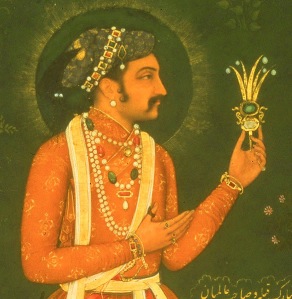Tags
Agra, ash gourd, Auspicious Conjunctions, First Lady, howdah, Mumtaz, Nur Manzil, pateesa, petha, Shah Jahan, taksh nashini, Timur
 ONCE SHAH JAHAN is summoned to Agra to assume the throne, he sets off from the Deccan. It is a journey of over two months and he makes a brief stop at the Nur Manzil before arriving at Agra. Returning to a city you have left long ago can be daunting, but riding in to be crowned Emperor is to write history; Shah Jahan proceeds along the city’s thoroughfare in a gilded howdah atop a majestic elephant. Yet he only enters the citadel through its Southern Gates at the precise time worked out by astrologers.
ONCE SHAH JAHAN is summoned to Agra to assume the throne, he sets off from the Deccan. It is a journey of over two months and he makes a brief stop at the Nur Manzil before arriving at Agra. Returning to a city you have left long ago can be daunting, but riding in to be crowned Emperor is to write history; Shah Jahan proceeds along the city’s thoroughfare in a gilded howdah atop a majestic elephant. Yet he only enters the citadel through its Southern Gates at the precise time worked out by astrologers.
He proceeds to the Hall of Audience where the takht nashini (ceremony of accession) takes place. He seats himself on the low, cushioned throne in the royal balcony as the khutba is pronounced. At 36, Shah Jahan is formally declared Emperor. The years of exile, waiting and planning, had been worth it. He takes on the title: sahib-qiran-i thani, Second Lord of Auspicious Conjunctions (Timur, his ancestor, being the First). Mumtaz Mahal, his wife and unfailing companion through his peregrinations, is given the rank of Nawab Mahd Aliya, First Lady.
Shah Jahan has been well instructed in the protocol for the day. After the coronation, he receives nazar (gifts of money) from the assembled nobility and distributes the same among the people. He also bestows titles and jagirs to officers, commanders, nobles and artists of distinction. Poets recite qasidas in his honour and there is dance and music. The ladies present him with nithar (gifts of money) which, after tradition, is distributed to the needy. Celebrations are marked by fireworks, a series of private banquets, and public food distribution where the common man, awam, is treated to innovative sweet delicacies such as pateesa, which is made from gram flour, and petha, a candy which is made out of ash gourd, an Indian vegetable of ancient vintage.
